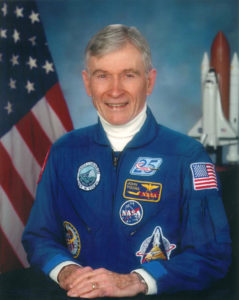
NASA is hiring new astronauts to explore the Moon and Mars! If you have what it takes to be an Artemis Generation astronaut, apply online March 2-31.
Photo by NASA
As NASA prepares to launch American astronauts this year on American rockets from American soil to the International Space Station – with an eye toward the Moon and Mars – the agency is announcing it will accept applications March 2 to 31 for the next class of Artemis Generation astronauts.
Since the 1960s, NASA has selected 350 people to train as astronaut candidates for its increasingly challenging missions to explore space. With 48 astronauts in the active astronaut corps, more will be needed to crew spacecraft bound for multiple destinations and propel exploration forward as part of Artemis missions and beyond.
We’re celebrating our 20th year of continuous presence aboard the International Space Station in low-Earth orbit this year, and we’re on the verge of sending the first woman and next man to the Moon by 2024,” said NASA Administrator Jim Bridenstine. “For the handful of highly talented women and men we will hire to join our diverse astronaut corps, it’s an incredible time in human spaceflight to be an astronaut. We’re asking all eligible Americans if they have what it to takes to apply beginning March 2.”
The basic requirements to apply include United States citizenship and a master’s degree in a STEM field, including engineering, biological science, physical science, computer science, or mathematics, from an accredited institution. The requirement for the master’s degree can also be met by:
- Two years (36 semester hours or 54 quarter hours) of work toward a Ph.D. program in a related science, technology, engineering or math field;
- A completed doctor of medicine or doctor of osteopathic medicine degree;
- Completion (or current enrollment that will result in completion by June 2021) of a nationally recognized test pilot school program.
Candidates also must have at least two years of related, progressively responsible professional experience, or at least 1,000 hours of pilot-in-command time in jet aircraft. Astronaut candidates must pass the NASA long-duration spaceflight physical.
Americans may apply to #BeAnAstronaut at: www.usajobs.gov
As part of the application process, applicants will, for the first time, be required to take an online assessment that will require up to two hours to complete.
After completing training, the new astronauts could launch on American rockets and spacecraft developed for NASA’s Commercial Crew Program to live and work aboard the International Space Station, 250 miles above Earth, where they will take part in experiments that benefit life at home and prepare us for more distant exploration.
They may also launch on NASA’s powerful new Space Launch System rocket and Orion spacecraft, docking the spacecraft at the Gateway in lunar orbit before taking a new human landing system to the Moon’s surface. After returning humans to the Moon in 2024, NASA plans to establish sustainable lunar exploration by 2028. Gaining new experiences on and around the Moon will prepare NASA to send the first humans to Mars in the mid-2030s.
NASA expects to select the new class of astronaut candidates in mid-2021 to begin training as the next class of Artemis Generation astronauts.
For more information about a career as a NASA astronaut, and application requirements, visit: NASA Astronauts Homepage

 Legendary astronaut John Young, who walked on the lunar surface during one of two trips to the Moon and commanded the first space shuttle mission, died Friday, Jan. 5, 2018, at the age of 87 from complications of pneumonia. Young began his impressive career at NASA in 1962, when he was selected from among hundreds of young pilots to join NASA’s second astronaut class, known as the “New Nine.”
Legendary astronaut John Young, who walked on the lunar surface during one of two trips to the Moon and commanded the first space shuttle mission, died Friday, Jan. 5, 2018, at the age of 87 from complications of pneumonia. Young began his impressive career at NASA in 1962, when he was selected from among hundreds of young pilots to join NASA’s second astronaut class, known as the “New Nine.” Legendary astronaut Eugene Cernan died Jan. 16, going to take his place “on God’s front porch,” as he so eloquently described his visit to the moon, and wait for someone else to take his place as “the last man on the moon.” Here are a few of the many tributes made to him:
Legendary astronaut Eugene Cernan died Jan. 16, going to take his place “on God’s front porch,” as he so eloquently described his visit to the moon, and wait for someone else to take his place as “the last man on the moon.” Here are a few of the many tributes made to him: By Mary Alys Cherry
By Mary Alys Cherry

